Korfball drills
You put four pawns in a square with a distance of 8 metres. Then you let the children make pairs. The children may take turns rolling the dice. You have three different rounds:
Round 1:
The children roll the dice. For example, if a group throws 4, each group must run 4 laps around the pawns.
Round 2:
The children first say who they are going to roll the dice for and then they get to roll passes. So they pick a group, say group 2 and roll the dice for that group.
Round 3:
The children first get to roll the dice and then they pick a group. This is almost always the most fun round. 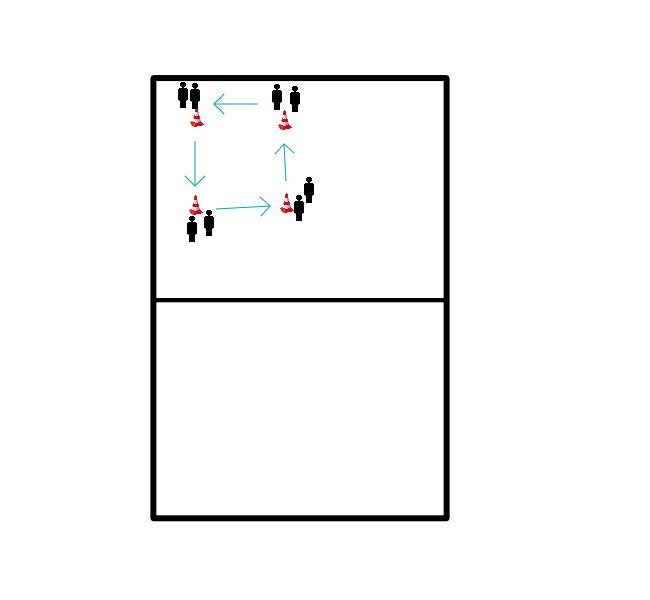
You put up three poles in a triangle, in the middle of the three poles you put a pawn. Three children are placed as attackers and the other children stand near the pawns.
First, you can choose that the attackers have to run through the poles. It doesn't matter which pole they hit, they can hit the same pole twice in a row. You can choose for this, so they have to run a lot. Also the children have to score 2 times, the person who scores first can trade with a declarator, the other children can trade with a declarator.
After that you can choose to letthe children do free balls, penalty throws, foul balls etc.
Everyone lies down on the floor like a plank, supporting themselves on their elbows with their legs extended. Then the children jump up and stretch all the way.
The whole group walks a circle around the yellow lines in the middle in a line. When the trainer calls 'yes', the person at the back of the line starts running as fast as possible. The children do this by pulling a sprint.
Options:
The children run after each other around the yellow lines in a line. The person at the front of the line can do whatever he wants for example: heels buttocks, sprints, lifts his knees etc. Whenthe trainer calls 'yes' the person at the back of the line starts to run as fast as possible and can choose what he wants to do. It must be something other than normal running/jogging, it may be sprinting.
3 men per basket. Player A starts as attacker in front of the basket. Player V starts as defender at 1,5 arm's length from the shooter. Player C starts with the ball in the box. Attacker A must try to score through the 1 on 1 duel. It does not matter how (distance, evasion, dlb). The defender's task is to follow the attacker at 1,5 arm's length and when the attacker has the ball in his hands, the defender has to close the gap. The defender is not allowed to tap or block balls. The V must show that she is with the attacker, but must allow the shot. This can be done by the defender placing her hand just above the shoulder of the attacker. After 1 minute, the V has to change position.
Korfball in 1 section. An attacking and a defending side, preferably 4 against 4, possibly with substitutes.
The attacking side puts the ball in play and tries to score a goal. After scoring or intercepting, the defending side attacks.
In the first case, the ball is taken out about 15 m. in front of the basket, in the second case it is first combined to this starting point.
The attacking side may try to intercept after losing the ball. If this is successful before the ball has been played to the starting point, then a goal opportunity may be played directly.
Note:
Emphasis is on playing the ball out well and defending consistently.
Variation:
After a goal, the attacking side keeps the attacking position. The team plays 2 minutes on ball possession. If the team succeeds in keeping the ball in the team for that long, or in scoring another goal, the goal is valid. If the defence intercepts the ball, the point is forfeited.
Complete team: One person is the ticker, and must tick off everyone. The other people have 2 balls at their disposal which they can pass around. You are not allowed to be tapped when you have the ball in your hands. So if the ticker is running to someone, you have to throw the ball to this player. Of course you are not allowed to hold on to the ball endlessly.
party with the whole group
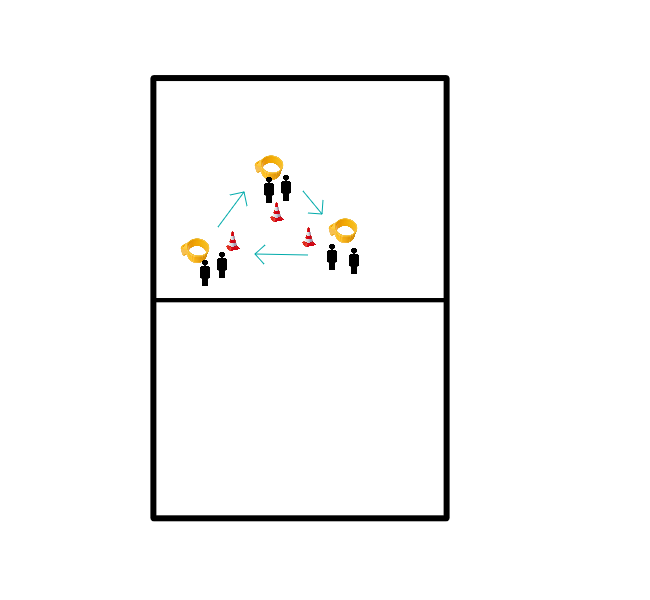 You have a pair at each pole, so the amount of poles depends on the size of the group. Everyone starts with scoring twice on the pole, when they have done this they go to the next pole. It can happen that two groups are standing at the same pole, this is because they don't all have to turn. The pairs only have to pass when they have scored twice.
You have a pair at each pole, so the amount of poles depends on the size of the group. Everyone starts with scoring twice on the pole, when they have done this they go to the next pole. It can happen that two groups are standing at the same pole, this is because they don't all have to turn. The pairs only have to pass when they have scored twice.
Place a pawn in front of the pole at a good distance for your team.
Everyone stands in a circle. One person is the loafer and stands in the circle. Everyone is going to throw the ball over, but the dummy has to try to take the ball away from him. The person with the ball can do this by intercepting the ball or by tapping the person who is holding the ball. When the lummel has taken the ball away, the lummel changes to the next player.
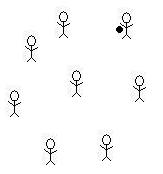
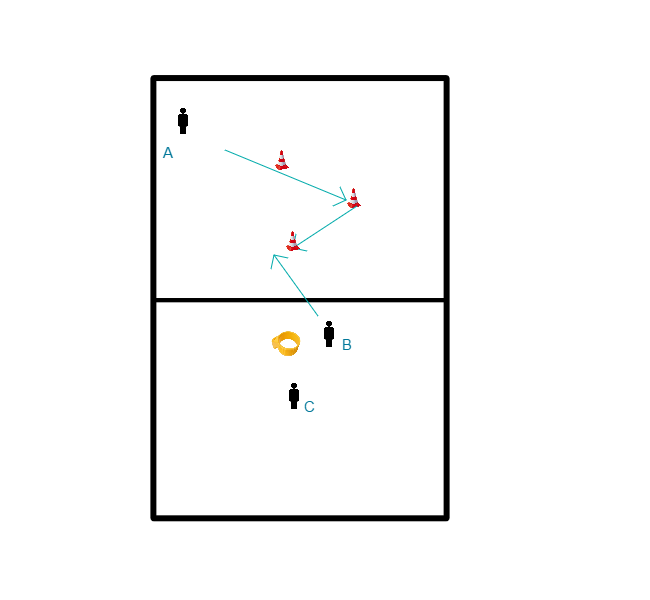 3 men per basket. Player A starts as shooter at the first pawn. Player B starts to pass with the ball under the basket. Player C starts as catcher under the basket. Player A runs with fast movements around all the pawns. At the last pawn player A stops and gets ready to shoot. The passer (player B) throws the ball and the shooter (player A) shoots. Player C catches the ball. The passer (B) is going to shoot, and the shooter is going to catch.
3 men per basket. Player A starts as shooter at the first pawn. Player B starts to pass with the ball under the basket. Player C starts as catcher under the basket. Player A runs with fast movements around all the pawns. At the last pawn player A stops and gets ready to shoot. The passer (player B) throws the ball and the shooter (player A) shoots. Player C catches the ball. The passer (B) is going to shoot, and the shooter is going to catch.
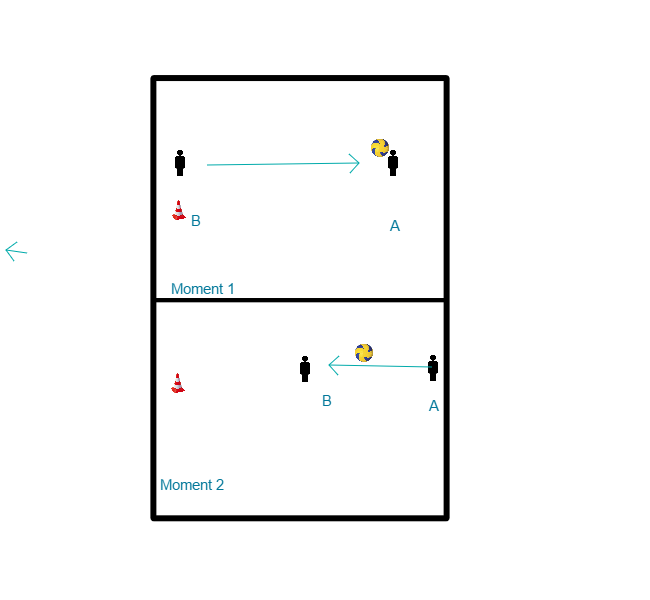 2 teams. Per pair 1 ball and 1 pawn. Player A stays on his spot. Player B starts with the pawn, which is about 10 meters away. Player B runs to player A. Player A throws (with 1 hand) the ball to player B. Player B keeps running until he has caught the ball and then stops. B throws the ball back and runs to the pawn to start the exercise again. after 10x change.
2 teams. Per pair 1 ball and 1 pawn. Player A stays on his spot. Player B starts with the pawn, which is about 10 meters away. Player B runs to player A. Player A throws (with 1 hand) the ball to player B. Player B keeps running until he has caught the ball and then stops. B throws the ball back and runs to the pawn to start the exercise again. after 10x change.







